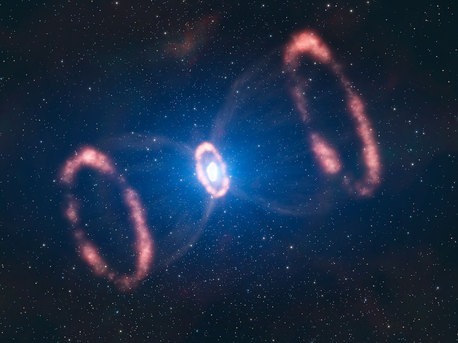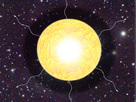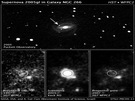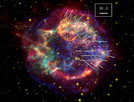Supernova 1987A
Seeing a Stellar Explosion in 3D
 © ESO/L. Calçada
|
This artist’s impression of the material around a recently exploded star, known as Supernova 1987A (or SN 1987A), is based on observations which have for the first time revealed a three dimensional view of the distribution of the expelled material. The observations were made by astronomers using ESO’s Very Large Telescope. The original blast was not only powerful, according to the new results. It was also more concentrated in one particular direction. This is a strong indication that the supernova must have been very turbulent, supporting the most recent computer models. This image shows the different elements present in SN 1987A: two outer rings, one inner ring and the deformed, innermost expelled material. Just how a supernova explodes is not very well understood, but the way the star exploded is imprinted on this inner material. The astronomers could deduce that this material was not ejected symmetrically in all directions, but rather seems to have had a preferred direction. Besides, this direction is different to what was expected from the position of the rings.
SN 1987A has been a bonanza for astrophysicists. It provided several notable observational ‘firsts’, like the detection of neutrinos from the collapsing inner stellar core triggering the explosion, the localisation on archival photographic plates of the star before it exploded, the signs of an asymmetric explosion, the direct observation of the radioactive elements produced during the blast, observation of the formation of dust in the supernova, as well as the detection of circumstellar and interstellar material.
New observations making use of a unique instrument, SINFONI [1], on ESO’s Very Large Telescope (VLT) have provided even deeper knowledge of this amazing event, as astronomers have now been able to obtain the first-ever 3D reconstruction of the central parts of the exploding material.
This view shows that the explosion was stronger and faster in some directions than others, leading to an irregular shape with some parts stretching out further into space.
The first material to be ejected from the explosion travelled at an incredible 100 million km per hour, which is about a tenth of the speed of light or around 100 000 times faster than a passenger jet. Even at this breakneck speed it has taken 10 years to reach a previously existing ring of gas and dust puffed out from the dying star. The images also demonstrate that another wave of material is travelling ten times more slowly and is being heated by radioactive elements created in the explosion.
"We have established the velocity distribution of the inner ejecta of Supernova 1987A,” says lead author Karina Kjær. “Just how a supernova explodes is not very well understood, but the way the star exploded is imprinted on this inner material. We can see that this material was not ejected symmetrically in all directions, but rather seems to have had a preferred direction. Besides, this direction is different to what was expected from the position of the ring.”
Such asymmetric behaviour was predicted by some of the most recent computer models of supernovae, which found that large-scale instabilities take place during the explosion. The new observations are thus the first direct confirmation of such models.
SINFONI is the leading instrument of its kind, and only the level of detail it affords allowed the team to draw their conclusions. Advanced adaptive optics systems counteracted the blurring effects of the Earth's atmosphere while a technique called integral field spectroscopy allowed the astronomers to study several parts of the supernova’s chaotic core simultaneously, leading to the build-up of the 3D image.
“Integral field spectroscopy is a special technique where for each pixel we get information about the nature and velocity of the gas,” says Kjær. “This means that besides the normal picture we also have the velocity along the line of sight. Because we know the time that has passed since the explosion, and because the material is moving outwards freely, we can convert this velocity into a distance. This gives us a picture of the inner ejecta as seen straight on and from the side.”
Notes
[1] The team used the SINFONI (Spectrograph for INtegral Field Observations in the Near Infrared) instrument mounted on ESO's Very Large Telescope (VLT). SINFONI is a near-infrared (1.1–2.45 µm) integral field spectrograph fed by an adaptive optics module.
Source: ESO
Supernova 1987A
Seeing a Stellar Explosion in 3D
 © ESO/L. Calçada
|
This artist’s impression of the material around a recently exploded star, known as Supernova 1987A (or SN 1987A), is based on observations which have for the first time revealed a three dimensional view of the distribution of the expelled material. The observations were made by astronomers using ESO’s Very Large Telescope. The original blast was not only powerful, according to the new results. It was also more concentrated in one particular direction. This is a strong indication that the supernova must have been very turbulent, supporting the most recent computer models. This image shows the different elements present in SN 1987A: two outer rings, one inner ring and the deformed, innermost expelled material. Just how a supernova explodes is not very well understood, but the way the star exploded is imprinted on this inner material. The astronomers could deduce that this material was not ejected symmetrically in all directions, but rather seems to have had a preferred direction. Besides, this direction is different to what was expected from the position of the rings.
SN 1987A has been a bonanza for astrophysicists. It provided several notable observational ‘firsts’, like the detection of neutrinos from the collapsing inner stellar core triggering the explosion, the localisation on archival photographic plates of the star before it exploded, the signs of an asymmetric explosion, the direct observation of the radioactive elements produced during the blast, observation of the formation of dust in the supernova, as well as the detection of circumstellar and interstellar material.
New observations making use of a unique instrument, SINFONI [1], on ESO’s Very Large Telescope (VLT) have provided even deeper knowledge of this amazing event, as astronomers have now been able to obtain the first-ever 3D reconstruction of the central parts of the exploding material.
This view shows that the explosion was stronger and faster in some directions than others, leading to an irregular shape with some parts stretching out further into space.
The first material to be ejected from the explosion travelled at an incredible 100 million km per hour, which is about a tenth of the speed of light or around 100 000 times faster than a passenger jet. Even at this breakneck speed it has taken 10 years to reach a previously existing ring of gas and dust puffed out from the dying star. The images also demonstrate that another wave of material is travelling ten times more slowly and is being heated by radioactive elements created in the explosion.
"We have established the velocity distribution of the inner ejecta of Supernova 1987A,” says lead author Karina Kjær. “Just how a supernova explodes is not very well understood, but the way the star exploded is imprinted on this inner material. We can see that this material was not ejected symmetrically in all directions, but rather seems to have had a preferred direction. Besides, this direction is different to what was expected from the position of the ring.”
Such asymmetric behaviour was predicted by some of the most recent computer models of supernovae, which found that large-scale instabilities take place during the explosion. The new observations are thus the first direct confirmation of such models.
SINFONI is the leading instrument of its kind, and only the level of detail it affords allowed the team to draw their conclusions. Advanced adaptive optics systems counteracted the blurring effects of the Earth's atmosphere while a technique called integral field spectroscopy allowed the astronomers to study several parts of the supernova’s chaotic core simultaneously, leading to the build-up of the 3D image.
“Integral field spectroscopy is a special technique where for each pixel we get information about the nature and velocity of the gas,” says Kjær. “This means that besides the normal picture we also have the velocity along the line of sight. Because we know the time that has passed since the explosion, and because the material is moving outwards freely, we can convert this velocity into a distance. This gives us a picture of the inner ejecta as seen straight on and from the side.”
Notes
[1] The team used the SINFONI (Spectrograph for INtegral Field Observations in the Near Infrared) instrument mounted on ESO's Very Large Telescope (VLT). SINFONI is a near-infrared (1.1–2.45 µm) integral field spectrograph fed by an adaptive optics module.
Source: ESO








